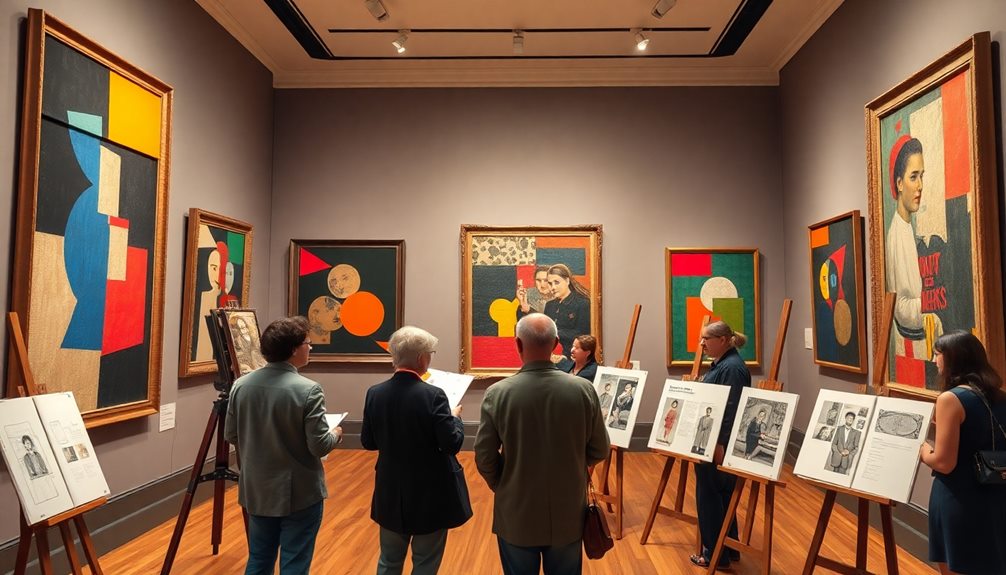To analyze art using formalism, focus on essential visual elements like line, shape, color, texture, and space. This approach prioritizes aesthetic value over narrative or historical context. You'll assess balance, contrast, movement, emphasis, and unity to understand how these elements contribute to the artwork's emotional experience. Key figures like Clement Greenberg have emphasized the importance of "significant form" in evoking feelings. By examining these core components, you can gain a deeper appreciation for the piece. There's much more to explore about how these elements interact within various artworks and what that reveals about artistic intentions.
Key Takeaways
- Formalism focuses on visual elements like line, shape, color, and texture, prioritizing aesthetic value over narrative or historical context.
- The concept of "significant form" suggests that formal qualities can evoke emotional experiences in viewers.
- Key principles of analysis include balance, contrast, movement, emphasis, and unity to guide the examination of artworks.
- Formalist analysis applies to various art forms, including painting, sculpture, and photography, emphasizing their inherent qualities.
- While celebrated for rigorous examination, formalism faces critique for potentially overlooking emotional and contextual significance in art.
Introduction

In the world of art analysis, Formalism stands out by emphasizing the visual elements of a piece rather than its narrative or historical context. When you engage with art through a Formalist lens, you focus on the fundamental components—line, shape, color, texture, and space. These elements are crucial in determining the artwork's aesthetic value, allowing you to appreciate the surface quality and the overall composition.
Just as in essential oils for aromatherapy, where the blend of different scents creates a harmonious experience, the combination of visual elements in art can evoke powerful emotional responses.
Emerging in the mid-19th century, Formalism arose as a reaction to movements like Impressionism and Post-Impressionism, which shifted attention to visual perception. Key figures, including Clement Greenberg and Clive Bell, introduced the concept of "significant form," arguing that the arrangement of these elements conveys emotional and aesthetic experiences.
As you analyze art through Formalism, consider essential components such as balance, contrast, movement, emphasis, and unity. These principles guide you in assessing how effectively the artist has orchestrated the visual elements.
Key Concepts and Definitions

Understanding the key concepts and definitions of Formalism is essential for effective art analysis. At its core, Formalism emphasizes the visual aspects of artwork, focusing on elements like color, line, shape, and texture. It prioritizes these features over narrative content or contextual meanings, allowing you to appreciate art for what it's rather than what it represents.
Additionally, just as in personal growth, awareness and reflection on your experiences can enhance your analytical skills, similar to how recognizing small mistakes can lead to personal development.
One of the pivotal ideas in Formalism is "significant form," introduced by Clive Bell. This concept posits that the formal qualities of a piece can evoke emotional experiences and aesthetic pleasure in the viewer.
Key figures like Clement Greenberg argued that art should be evaluated based on its structural components rather than any representational or social commentary it may contain.
When engaging in Formalist analysis, you'll want to explore the relationships and interactions among compositional elements to understand an artwork's overall impact. This approach aligns with the philosophy of "art for art's sake," which advocates for the appreciation of pure form, free from external meanings or moral implications.
Formalist Analysis Framework

The Formalist Analysis Framework provides a structured approach to evaluating art by concentrating on visual elements like line, shape, color, and texture. This framework emphasizes the relationships between these formal elements, allowing you to assess how they contribute to the overall form of the artwork.
You'll find that the evaluation focuses on "significant form," a concept introduced by Clive Bell, which posits that an artwork's form conveys emotional and aesthetic experiences independent of its subject matter. Just as in top projectors for gaming enthusiasts, where high refresh rates and low input lag enhance the experience, a careful analysis of formal elements can elevate your understanding of art's impact.
As you engage with the artwork, consider the Principles of Design: balance, contrast, movement, emphasis, and unity. These principles guide your analysis, revealing how various shapes and elements work together to create a cohesive composition.
This method emerged as a critical response to earlier movements like Impressionism, which prioritized light and color over formal structure. By applying this framework, you can appreciate the intrinsic qualities of both traditional and modern abstract art.
It's applicable to various art forms, including painting, sculpture, and photography, making it a versatile tool for understanding art's visual language.
Notable Artworks in Analysis

While exploring notable artworks through a Formalist lens, you'll discover how each piece exemplifies the principles of design and significant form.
Henri Matisse's "The Dance" stands out with its vibrant colors and rhythmic composition, emphasizing emotional impact over narrative content. This work of art highlights how Formalism prioritizes formal elements in artistic expression.
Piet Mondrian's "Composition II in Red, Blue, and Yellow" embodies geometric simplicity, showcasing the harmony of color and line to create a pure visual experience. This piece reveals how geometric shapes can evoke aesthetic pleasure.
Similarly, Wassily Kandinsky's "Composition VIII" employs dynamic color and shape to reflect the emotional qualities of abstraction, further illustrating the core tenets of Formalist analysis.
Jackson Pollock's "No. 5, 1948" takes a different approach, focusing on the act of painting itself. Here, the physicality of paint creates a visual dialogue devoid of representational content, aligning with Formalist principles.
Lastly, Clive Bell's notion of "significant form" is evident in Paul Cézanne's works, where the arrangement of shapes and colors evokes deep aesthetic emotions, reinforcing the importance of Formalism in art analysis.
Tips and Best Practices

To effectively analyze artworks through a Formalist lens, focus on the visual elements that shape the piece. Start by examining the surface and consider how the Elements of Art—line, shape, color, texture, and space—interact to create the overall composition.
Identify the techniques used to create balance and contrast, noting how these principles guide the viewer's eye and establish a sense of harmony or tension.
Next, assess movement within the artwork. Look at how the arrangement of elements directs your gaze and influences emotional responses. This can significantly impact your understanding of the piece.
Pay attention to the emphasis placed on specific areas, determining how these focal points are achieved through careful contrast and arrangement of formal elements.
Critical Acclaim and Critique

Critical acclaim for Formalist art analysis shines a spotlight on its rigorous examination of compositional elements like line, shape, and color, often setting aside external context or narrative content. Prominent critics, especially Clement Greenberg, have championed Formalism for its intellectual rigor, arguing that it elevates discussions around nonobjective art beyond mere representation. This focus on aesthetic qualities has garnered significant recognition within the art community.
However, this acclaim isn't without critique. Detractors argue that Formalism's detachment from social and political issues reduces art to a quietist practice, ignoring the pressing concerns of its time. Critics contend that by emphasizing purely aesthetic elements, Formalism overlooks the emotional and contextual significance of artworks, potentially limiting their power as agents of social change.
The New Criterion, which reflects Formalist principles, serves as a key platform shaping critical discourse in North America. While it influences how contemporary art is received and interpreted, the debate continues about whether a purely formal approach can adequately address the complexities of art's role in society.
Ultimately, understanding these dynamics is essential for engaging with Formalism and its impact on art criticism.
Audience Interpretation Variability

Understanding the complexities of audience interpretation in Formalist art reveals how personal experiences and cultural backgrounds shape individual responses. The subjective nature of audience interpretation means that two viewers can have entirely different emotional reactions to the same artwork. This variability stems from how you engage with the visual elements like color, line, and shape, which are central to formalism. Instead of focusing on narrative context, you find meaning through aesthetic appreciation, allowing personal feelings to influence your interpretation.
Art historians note that viewers often project their own associations onto abstract forms, creating interpretations that might stray from the artist's original intent. The environment where you encounter a piece—along with any accompanying texts or the social setting—can significantly impact your interpretation.
Formalist art encourages you to critically engage with the artwork's inherent qualities, emphasizing form over external narratives. As you explore formalist art, remember that your unique perspective enriches the conversation, contributing to a diverse understanding of the piece. In this way, each interpretation becomes a reflection of both the artwork and the viewer, showcasing the dynamic relationship between art and audience.
Additional Resources

Numerous resources can enhance your exploration of Formalist art analysis and education. For instance, the National Endowment for the Arts offers federal funding opportunities that support cultural projects aligning with ideas of formalism. This funding can help you access local initiatives that focus on Formalism in Modern art.
You might also consider community engagement programs funded by the Morris and Gwendolyn Cafritz Foundation, which promote outreach to underserved communities, allowing you to witness how Formalist principles can enrich various cultural contexts.
Additionally, platforms like the Kennedy Center Education and Little Kids Rock provide teaching tools and methods that emphasize effective art education, helping you deepen your understanding of art from a Formalist perspective.
If you're interested in auditory art forms, online tools like Soundtrap can aid your exploration of Formalism in Modern music.
Professional development initiatives for educators also foster a deeper understanding of Formalist analysis, ensuring that students grasp the significance of form and composition in art, as championed by American critic Clement Greenberg.
Utilizing these resources will empower you to engage with Formalist art analysis more meaningfully.
Frequently Asked Questions
What Are the Elements of Formalism in Art?
In art, you'll find elements like line, shape, form, space, and color. Each one plays a vital role, shaping your visual experience and guiding your emotional response to the artwork before you.
What Factors Are Considered in a Formalist Analysis of Artwork?
In a formalist analysis, you'll consider elements like line, shape, color, space, and texture. You'll also examine balance, contrast, movement, emphasis, and unity to understand how these factors affect the artwork's visual impact.
What Are the Elements of a Formalist?
In a formalist approach, you focus on elements like line, shape, form, color, and texture. Each element plays a crucial role in shaping your understanding and appreciation of the artwork's overall visual impact.
What Is the Analysis of Formalism in Art?
When you analyze formalism in art, you focus on elements like color, line, and shape. It's all about how these components interact to create meaning and evoke emotions, independent of the subject matter.
Conclusion
In conclusion, understanding the essential elements of formalist art analysis empowers you to appreciate art on a deeper level. By focusing on the visual components and their relationships, you can uncover the intricate details that make each piece unique. Remember to apply the framework and tips discussed, and don't hesitate to explore various interpretations. Embrace the journey of discovery in art, as it enhances your viewing experience and enriches your appreciation for creativity.









